by Winding Pathways | May 23, 2024 | Nature, Reflections/Profiles
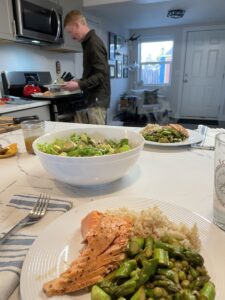
Salmon is delicious and healthy.
On an April morning, we discovered three fish that had spent their lives circling the North Pacific Ocean on our porch in Iowa. Three delicious sockeye salmon landed on our porch. We quickly converted them to delicious meals.
How’s that possible?
Back In Time
The story goes back to 1971 when Rich was a biologist working for the Alaska Department of Fish and Game. “For days the Ugashik River seemed empty of salmon. Then I glanced downstream to see an immense swarm of bright red fish heading my way.” It was the first wave of hundreds of sockeyes that passed by that summer to ascend tributaries to spawn and die.
What Sockeye Salmon Eat
Unlike other salmon species that mostly eat small fish, crabs, and squid, small sockeyes, called smolts, leave freshwater and spend a year, sometimes two years, circling the ocean with their mouths open. They strain zooplankton from the water. Many of these tiny animals are reddish and the color permeates the flesh of Sockeyes, sometimes called Red Salmon.
During his years in Alaska Rich had the chance to eat many fish species, but the Sockeye was his favorite. “They’re delicious, perhaps because they eat low on the food chain. This also keeps them relatively free of contaminants common in other species. I can eat Sockeye without guilt. Thanks to excellent management millions of them swim in the ocean. Biologists make sure that plenty survive fishing nets to ascend rivers to spawn. In recent years Sockeyes have increased,” he said.
Where Get Sockeye Salmon?
Although Sockeye’s are delicious and abundant it’s hard to buy frozen fillets in Iowa.
The Popsie Fish Company solved the problem. The box we found on our porch contained six frozen fillets of Sockeyes caught near Egegik, Alaska.
“We’re beach netters. We stretch gill nets from the beach out into Bristol Bay. Sockeye get tangled in the nets. When the tide goes down, we take the fish from the nets, and fillet and freeze them. Then we ship them everywhere to customers like Rich and Marion Patterson, “said Tony Neal, owner.
These fish are caught and processed right here in the United States.
-
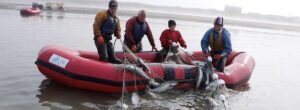
-
Gill netting
-
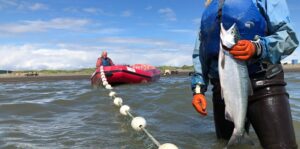
-
A freshly caught sockeye salmon.
Expensive. It costs about $250 to have ten pounds of fillets sent to our home, but prime beef cuts purchased locally cost about the same, and finding quality fish locally is not easy. All Sockeye salmon sold are wild fish that spent their lives freely swimming in the ocean. That contrasts with today’s beef, pork, chicken, and Atlantic salmon which are crammed together and totally confined.
What is “Atlantic Salmon?”
Any fish marked “Atlantic Salmon” came from a fish factory farm with thousands of fish confined in a huge tank or pen in the ocean. They’re fed a concentrated human-created diet and never have the chance to swim freely in the ocean. They may contain antibiotics.
When in the grocery store look closely at a package of frozen fish that says, “Wild Alaskan” on the label. In fine print it probably says a product of China. Yup, many fish are caught in Alaska, frozen, shipped to China for processing, and refrozen. They are then sent across the ocean and land to the grocery store. Quality suffers.
We love fish and whenever we’re down to the last frozen fillet of Popsie Fish Company’s Sockeye we’ll put in an order for another box to appear on our porch.
A Quick Guide to Salmon
Found in Groceries
Pink Salmon. The most abundant and smallest species of Pacific salmon. Usually the least expensive. Caught in nets.
Coho or Silver Salmon. Normally the latest run of all salmon and available fresh in late summer. Caught in nets and by hook and line. Some are farmed.
King or Chinook Salmon. The largest salmon species and hard to find in the store. Mostly wild caught but some are farmed in New Zealand.
Chum or Dog Salmon. A medium-sized fish usually fairly low-priced and wild-caught.
Sockeye Salmon. The tastiest salmon according to Rich. Always wild and net-capted.
Atlantic Salmon. Not a salmon at all but in a different genus. All Atlantic Salmon on the market are farmed, mostly in Canada, Norway, or Chile.
-
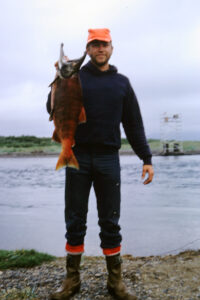
-
Good Catch
-
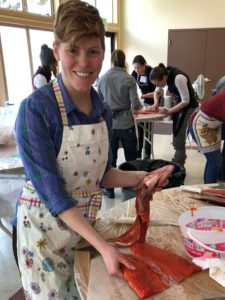
-
Filleting salmon.
-
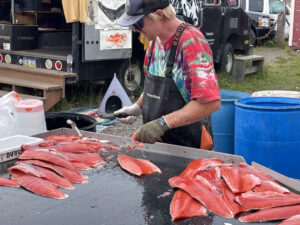
-
Processing salmon
by Winding Pathways | May 16, 2024 | Reflections/Profiles
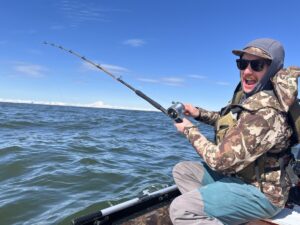
Fishing with Grandpa’s Reel.
Legacy Fishing Reel
Our son-in-law, Brian Ohlen, shared a photo of a delightful legacy. He is grinning as he works his reel hauling in a fish from Alaskan waters. It wasn’t just an ordinary reel. He is using a legacy fishing reel.
Rich’s father, Henry Patterson, was a dedicated angler. He loved fishing the ocean off New Jersey. Normally, Dad used inexpensive rods and reels but years ago he bought a top-quality Penn Senator reel. Over the years it helped him catch cod, pollock, flounders, sea bass, and bluefish.
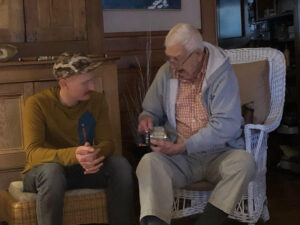
Grandpa gifting legacy reel to Brian.
In October 1919 our daughter Nancy and her husband Brian trekked from their Alaska home to visit Dad in New Jersey. Knowing that age would keep him from again fishing the ocean, Dad handed his trusty Penn to Brian and said, “Catch me a fish on my reel.”
It took a while, but in 2024 Brian bought a rod suitable to mate with the Penn, spooled on a new line, and went a fishin’. Sure enough, he caught a codfish…….Henry’s cod.
Legacies
When Henry handed that reel to Brian it came with a lifelong memory of fun fishing times and delicious meals of fresh fish. Brian continues the tradition attached to that reel.
A couple of factors helped create a fishing legacy. Certainly, important is the reel itself.
Extremely well-designed and crafted, the reel was made to handle big fish for years and years. A cheapo counterpart almost certainly would have been in Dad’s trash bin years ago.
Memories are Legacies
Another legacy factor was Dad’s gifting his reel to Brian. Dad knew he’d not be able to use it again, but Brian, a fishing enthusiast, might get years of pleasure from it. So, the transfer was made.
As we all get older, we have similar prized possessions. Tools, camping gear, sewing machines, sports equipment, household items, books, cutlery, and myriad other fun, functional, and beloved items that have stood the test of time and have more years left in them. Turning these legacies over to a younger person lets these objects span generations.
Carrying on the Tradition
Dad died a few years after giving his reel to Brian but in his later years, I’m sure he sometimes formed a mental image of Brian in a boat bouncing in Alaskan waves with a codfish or halibut coming up from the bottom with the help of HIS legacy fishing reel.
by Winding Pathways | Apr 25, 2024 | Nature, Reflections/Profiles, Travel/Columns
The steep climb got us huffing and puffing until we crested the hill and looked around. Beneath us was a spacious pond and on the far hillside cattle grazed in the evening’s dwindling light. Oncoming darkness, combined with tired leg muscles, encouraged us to circle back to the historic farmhouse where we overnighted.
It sounds like a Montana adventure, perhaps at the spacious American Prairie, but it isn’t. We were at Iowa’s Whiterock Conservancy, a remarkable landscape just south of the tiny town of Coon Rapids in the west central part of Iowa.
What IS Whiterock Conservancy?
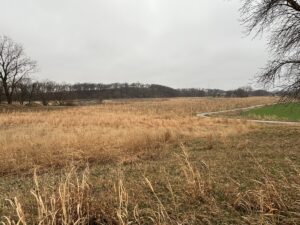
Bike or hike or ride your way along miles of intriguing trails.
Whitrock defies the norm in a state short on places big enough for outdoor enthusiasts who love spaciousness. Winding through its 5,500 acres are about 40 miles of trails that welcome hikers, mountain bikers, equestrians or folks just wishing to walk away from the noise and distractions of modern life. Whiterock is a place to enjoy the quiet and the dark sky of this lightly settled region.
There’s more. Whiterock Conservancy, named for an outcropping rising above a campground, is a testament to the formation of modern agriculture. Roswell Garst farmed the land and enthusiastically promoted hybrid corn. He was a force enabling the land to dramatically increase its production of food.
Entrepreneur, Ambassador, Visionaries
Garst was also an ambassador of sorts and invited his friend, Soviet Premier Nikita Khrushchev, to visit in 1959. The Russian was eager to find ways to expand his country’s food production. For a day the world came to the Garst Farm and Coon Rapids, Iowa. Dignitaries, reporters, and even some possible Soviet Spies were everywhere. The story is that one could tell the “spies” because, in this decidedly farm community, they were the only ones dressed in suits.
The Garst Family was visionary. Rather than sell their land for massive modern agriculture they encouraged the development of the land trust that combines agriculture and outdoor recreation in creative mosaics.
What’s There
After our walk and a picnic dinner, we settled down for the night in the old Garst Farmhouse, marveling at the collection of books, vintage furniture, and artifacts from Khrushchev’s visit inside. Its style was reminiscent of old-time New England homes – low ceilings, a newell post at the end of the stairs, wainscotting, tiled bathrooms, wallpapered ceilings, drapery on the windows, period cookware, and elegant teacups nestled in a corner cupboard. A swing-through door led to the well-equipped kitchen that looked out over a play yard and firepit. We could almost hear Roswell Garst talking up hybrid corn.
How It Came About
The Whiterock Conservancy was created as a nonprofit land trust about 20 years ago. Today it’s a progressive, innovative, and fascinating organization that combines agriculture, ecological restoration, lodging, and outdoor recreation spread over more than 5,000 acres.
We watched the cattle graze, listened as a flock of goats “baaahed” in anticipation of their dinner, drove miles of gravel roads through the property, and walked several trails. Perhaps our favorite was admiring the winter worn prairie grasses and forbs still standing sturdily in a brisk spring wind that rippled the pond’s water.
Things To Do at Whiterock Conservancy
Our short visit just whetted our appetite for the outdoors, and we plan to return. Here are some of many activities welcomed on the land:
-
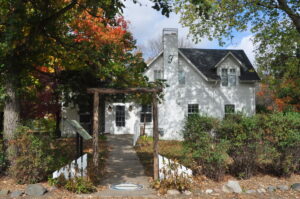
-
Period style farmstead that greeted Nikita Khrushchev. Photo Credit Whiterock Conservancy.
-
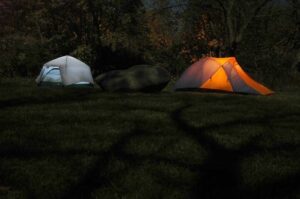
-
Tenting along the river. Photo credit Whiterock Conservancy.
-
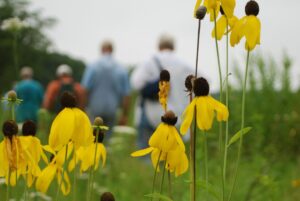
-
The Conservancy hosts a variety of programs. Photo credit Whiterock Conservancy
Camping: Several smallish and rather rustic campgrounds invite overnighters seeking quiet and gorgeous star viewing.
Trails: Well planned and maintained trails wind through hills, prairies, wetlands, and ravines. Hikers, equestrians, and mountain bikers are all welcome.
Home and cabins: Several indoor lodging options range from staying in one of many rooms in the historic farmhouse, to a nearby cottage. There’s even a walk-in cabin.
Activities: Staff and volunteers sponsor periodic programs to help visitors enjoy and appreciate nature and the Conservancy.
Fishing and Hunting: Visitors bearing an Iowa fishing license are welcome to try catching dinner from a dozen ponds scattered about the land. Check with headquarters about bowhunting.
Learn More and Visit!
The Whiterock Conservancy is a nonprofit land trust, funded by donations and grants. A list of fees and information is posted on their website. Donations are suggested for trail users and can be put in convenient boxes near trailheads. We so enjoyed the stay and visit with the staff.
by Winding Pathways | Mar 14, 2024 | 1080 Labyrinth Blog, Labyrinths, Reflections/Profiles, Uncategorized
Who Is Stargirl?
Stargirl taught us to notice…to care. You know Stargirl, the spritely, hippie-seeming girl in the Jerry Spinelli story of the same title who showed up at a high school, wrote notes to people, played the ukelele, was nice to everyone, and even cheered the other team’s successes. She turned typical high school life upside down. And, then, vanished.
We walk today in her spirit. Usually ground underfoot is stone-cold and rigid. But with this “winter that hasn’t been” mole humps yield underfoot. We pause by the bell of the Phoenix Harmony Labyrinth.
Cookie Monster has nibbled the rim of the waning Gibbous moon as it slips west. Guided by moon shadows we walk.
-
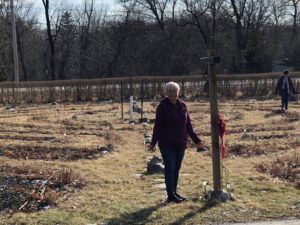
-
Teri blesses the labyrinth
-
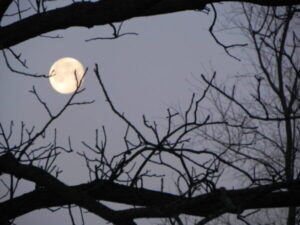
-
Tree branches help you watch the moon move across the sky.
From the south Mother West Wind shakes out the Merry Little Breezes. Off they skitter tickling the tops of the firs and rustling the winter-weary leaves of the Derecho-damaged oak.
Four Directions
Stop. Breathe in the air. Neither too cold nor too muggy. It’s Goldilocks. Just right.
To the east, a smear of red on the horizon separates the black earth from the velvet sky. Father Sun, starting to wake up, stretches his rosy fingers. Yet, stars still sprinkle the sky.
The ancient basswood tree full of gaping holes stands silhouetted. How did it survive when the sturdy oak shattered? Perhaps because it didn’t resist?
Totems
Vultures return in March. In fact, I saw one the other day soaring overhead. Checking out the basswood that has been home of vulture families for generations. Some people don’t like vultures because they are homely and eat dead stuff. Who among us is a Hollywood beauty?
As for eating dead stuff, good thing they do…One of Mother Nature’s cleanup crew. Otherwise, we would be knee-deep in rot. Maybe we are anyway. Good parents their keen eyesight and sharp smell lead them to meals which they feed their babies until they fledge.
Watching the young on their first flights as they swoop down, cross the labyrinth, then flap mightily to land in the fir on the far side is always a thrill. Vultures are good totems.
The pause by the birches feels like home. New England. Robert Frost wrote it well: “When I see birches bend to left and right Across the lines of straighter darker trees, I like to think some boy’s been swinging them. But swinging doesn’t bend them down to stay. Ice-storms do.”
Call and Response
Ahh, off in the woods a call and response as two cardinals awaken and call. A turkey gobbles from a tree top.
At the Center of the labyrinth, I thank the earth elements, plant and animal kingdom, those I have known. I send Grace to those I dislike, which helps me most. I stop and thank guides and Divine love.
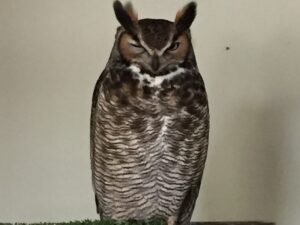
Injured owls find a safe home at the International Owl Center.
An owl floats past. Silent yet hearing, unseen yet seeing all. Quiet knowing. Carrying us through the night into the day.
To the north the Big Dipper’s handle swings off to Arcturus and look! A shooting star blazes brightly dropping into the North Star.
Stargirl is with us.
by Marion Patterson | Mar 7, 2024 | Reflections/Profiles, Wonderment
Dupuytren’s Contracture: The Curse of the Vikings! Usually, we blog about nature and yards at Winding Pathways, but once in a while, we digress. This one’s about Rich’s Dupuytren’s adventure. But it is related to nature, as putting on gloves and manipulating his hand was becoming more difficult as two of his fingers began to curl. Also, genetics is nature.
Dupuytren’s Contracture is fairly common. It runs in families. The fingers on Rich’s Dad, Henry Patterson, curled so severely that manipulating tools, knobs, buttons, and eating utensils became difficult despite two surgeries to correct the condition.
Curse of the Vikings
So, what is it? Dupuytren’s Contracture was named for a French surgeon who described it first. It’s most common in men with Northern European ancestry, especially from Scandinavia and Scotland. That fits. Rich’s ancestors were from Denmark and Germany.
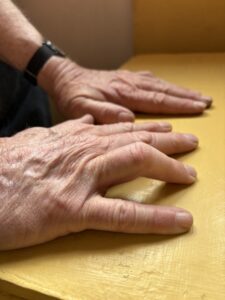
It’s caused when a knot of fascia forms under the skin usually in the palms beneath the ring finger and pinky. Sometimes a hard cord of material grows up the finger, forcing it to curl downward. Eventually, the finger can curl to about 90 degrees from the palm.
Women can get the condition, but less frequently than men, and often it’s not as severe.
Watchful
Rich first noticed a knot in his palm when he was 55 years old and gradually two of his fingers began to curl, making it impossible for them to lay flat on a table. There’s no way to predict whether Dupuytren’s will continue to grow or ever become a problem.
For many years Rich’s hand functioned normally with a slightly curved ring finger.
Doing Something About This
About two years ago he visited Dr. Clifford Novak, a hand surgeon at Cedar Rapids’ Physicians Clinic of Iowa. He encouraged Rich to return if the condition worsened or interfered with everyday activities. It started to, so in mid-2023 he again visited Dr. Novak and learned of three possible treatments: surgery to remove the material, needle aponeurotomy to cut the long cord causing the curl, and chemical treatment.
Because his condition was not profound and recovery sounded the easiest, he chose the needle method.
Surgery
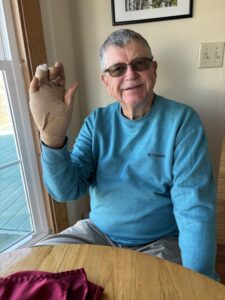
The hand was bandaged for four days.
On February 23, 2023, Dr. Novak performed the surgery. Rich stayed in the outpatient Surgery Center for just four hours. He left with his hand heavily bandaged, making typing and any other form of manipulation difficult….but for only four days. On February 27th a physical therapist removed the bandages and gave Rich a series of exercises to help straighten the finger. Amazingly there were no sores or scars where the needles were inserted. For the first time in several years, he could lay all his fingers flat on a table. There was no pain. The result is amazing.
Follow-Up
There’s no assurance the Dupuytren won’t grow back in the same finger or progress in other fingers, but the surgery was so successful it could be repeated if needed.
Dr. Novak’s advice was to treat the curled finger BEFORE it became difficult to use.
Rich did this with success as these after photos reveal.
-
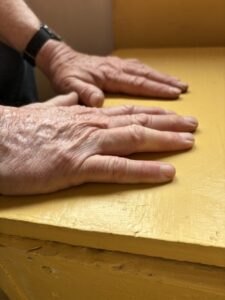
-
Improved straightened finger.
-
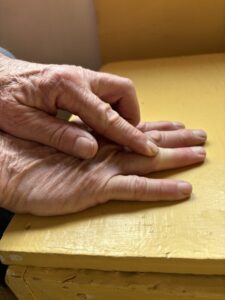
-
Exercises are simple and critical to recovering use of the finger.
by Winding Pathways | Feb 1, 2024 | Preparedness, Reflections/Profiles
Phone Call Sets In Motion Action
In early 2005 Rich received an attention-grabbing phone call that set in motion a prostate Cancer Adventure.
“Are you sitting down?” Dr. Rippentrop asked. “Yup,” Rich replied. “You have prostate cancer. Come to my office tomorrow and bring Marion. I’m going to give you options,” he said.
A cancer physician with a robust sense of humor is worth his or her weight in gold, and Dr. Jon Rippentrop shared his wondrous humor that’s stacked on solid medical credentials. As we sat nervously in his office he winked and said, “You have no symptoms and feel good. You don’t need to do anything about your prostate cancer……and the good news is you won’t have to do any retirement planning!!!!” We chuckled at his humor because we knew he was about to give us hopeful options.
Treatments
Then he presented several possible treatments for this prostate cancer adventure. We chose to proceed quickly with surgery and, later, radiation. On December 27, nearly 18 full years after his prostate was removed Rich had a semiannual meeting with Dr. Rippentrop. Rich’s PSA test showed undetectable. “Looks great!” said the doctor.
Science works. Wise researchers developed the PSA test and our astute family doctor noted Rich’s rising psa during annual blood tests before physicals. She referred him to urologist surgeon Dr. Rippentrop, who conducted robotic surgery. It worked.
Rich has enjoyed good health all these years and is appreciative of the outstanding science and wise physicians who helped him along his cancer journey. Fortunately, prostate cancer, like some other cancers, responds well to early detection and treatment.
Back Sliding in Receptivity to Scientific Knowledge
Modern medicine is amazing but there is sad news. Charles Kenny’s relatively new book, THE PLAGUE CYCLE, is a history of how medical researchers learned to prevent or cure many contagious diseases that felled millions of people in years not far back. Both Rich and Marion remember receiving the then newly developed polio vaccine they took as children. Certainly, their parents were appreciative of the new vaccine. The polio scourge that struck so many children is now virtually unknown. Thanks to science. While cancer is different from microbes that spawn contagious diseases, scientific advancements over decades help ALL live healthy lives. Sometimes we take this for granted.
Kenny’s last chapter reveals disturbing medical backsliding. Far too many people believe Internet hucksters who plant unfounded fear of modern medical treatments and vaccines.
Ruining Everyone’s Day
A diagnosis of a disease or contagion alters people’s lives. Avoiding vaccinations puts lives at unnecessary risk.
Prostate cancer isn’t caused by a microbe and has no symptoms in its early stage. The PSA test helps a physician identify and treat it using a variety of techniques while there’s still time. It’s a lifesaver.
Winding Pathways owners Marion and Rich Patterson urge everyone to get annual physicals, appropriate medical tests, and vaccinations.



















